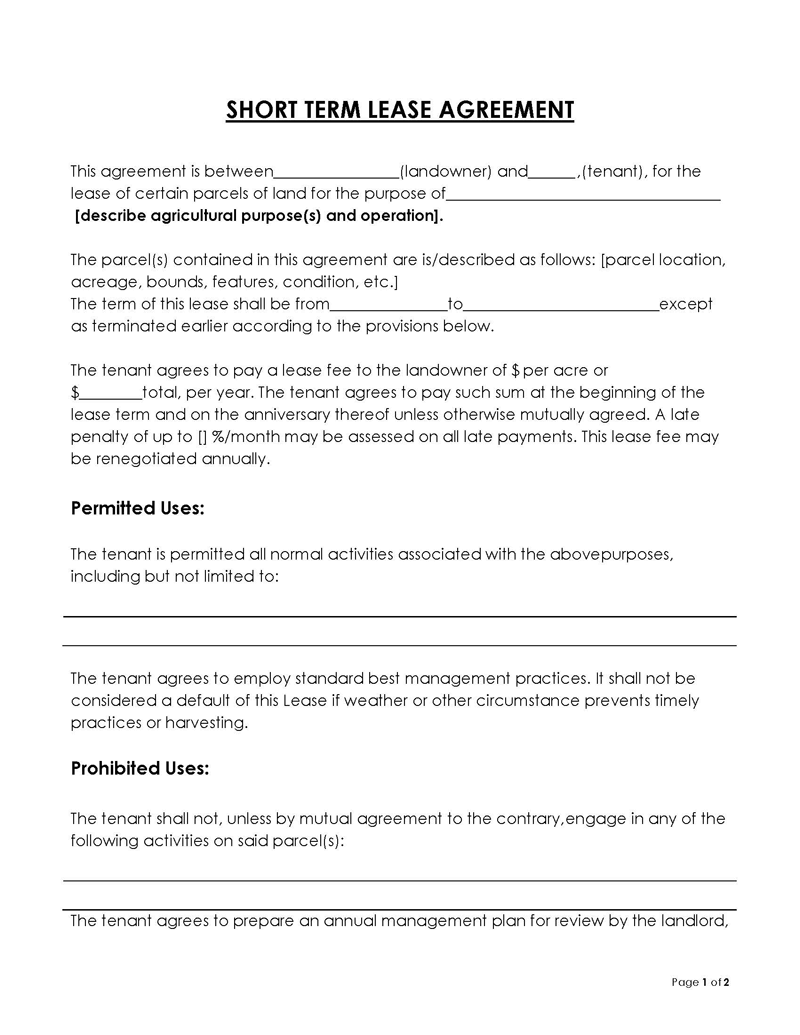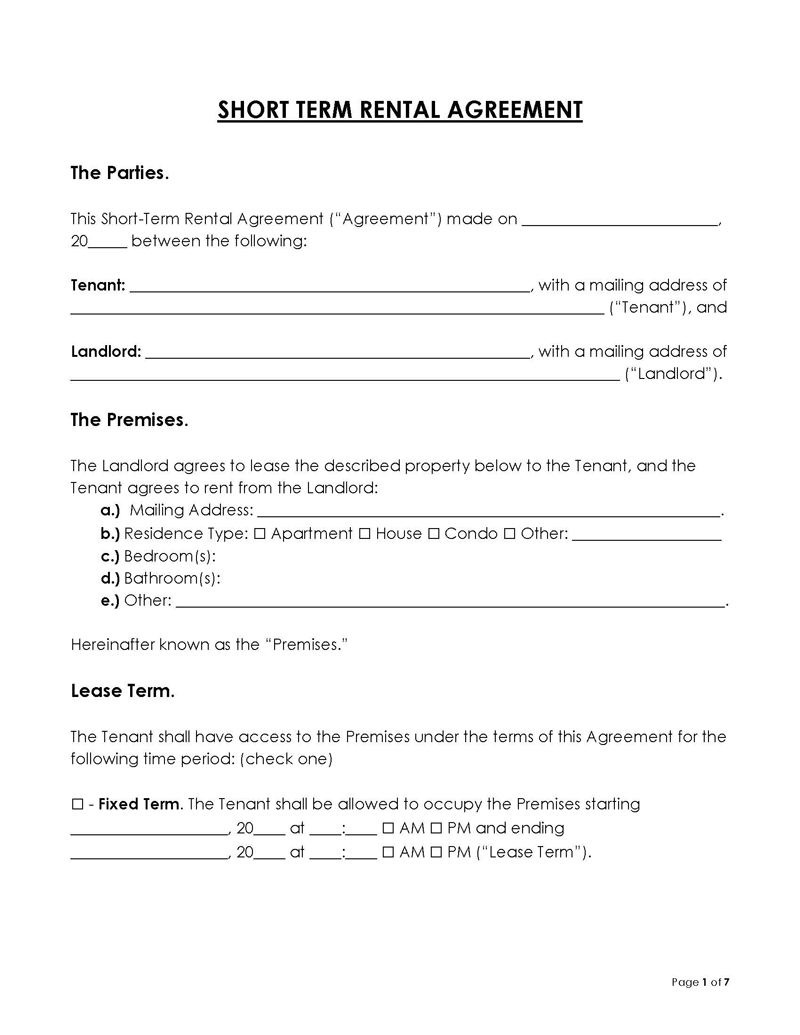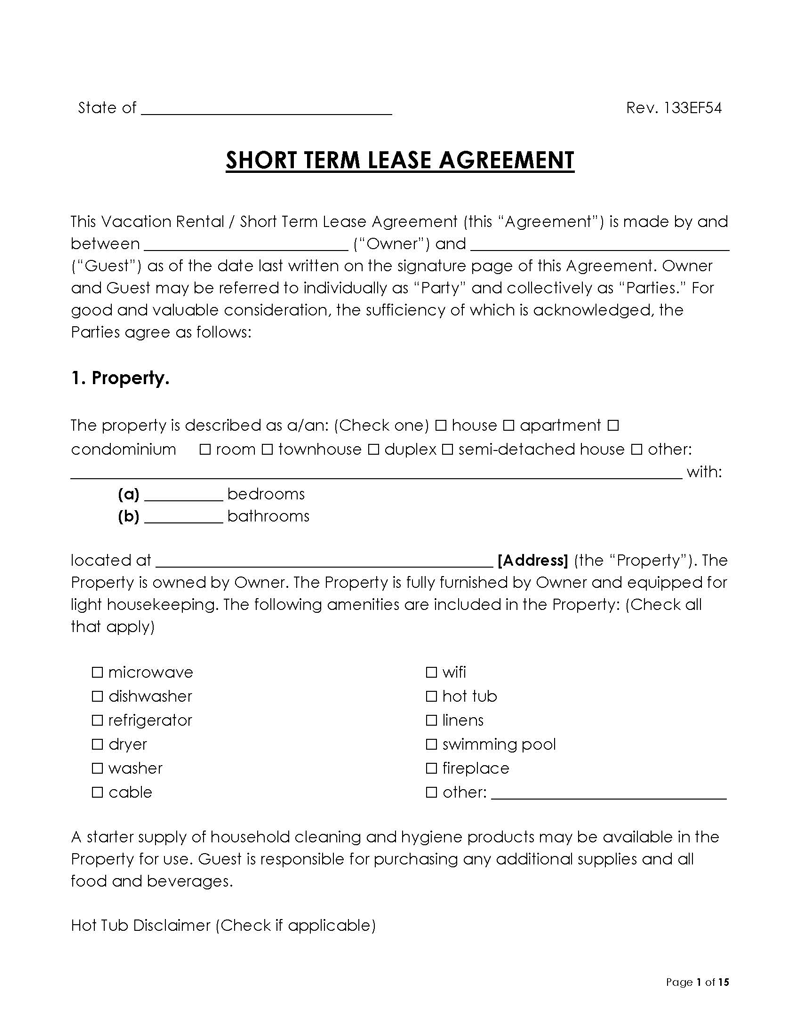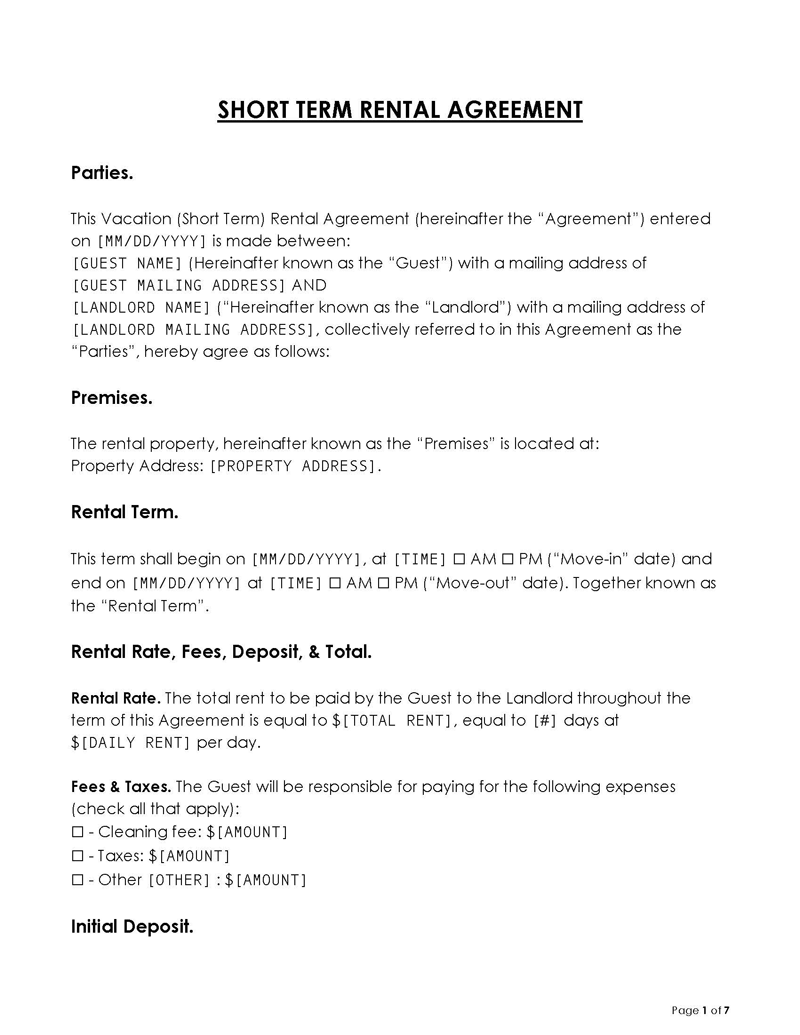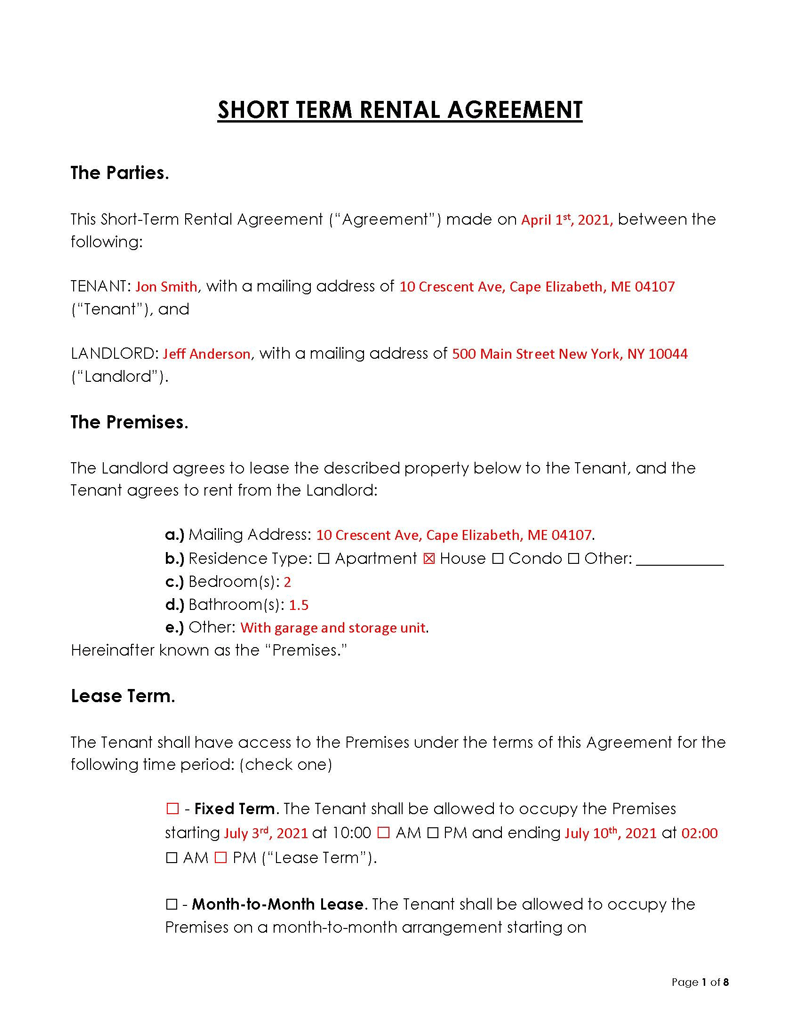When you are looking to rent out a property for reasons such as education, seminars, travel, etc., depending on the duration of the tenancy, a short-term residential lease agreement may be what you need. A short-term lease agreement differs from a typical residential lease agreement in that the tenant may only stay for a specified period and will not reside there as their primary residence.
Short-term lease agreements are usually negotiated between a property owner and a rental property management company that manages the property or a landlord and the tenant, depending on the duration of the tenant’s stay.
This article discusses everything you need to know about short-term lease agreements, including how to create one, the pros and cons of short terms lease agreements, and effective practices to be a good host.
Short Term Lease Agreement Templates
As a landlord, ensuring that you have a short-term lease agreement template is always essential. The most important reason for having a template is that it allows you to ensure that you have all the essential elements in your lease agreement. When tenants rent an apartment or unit from you, they must be informed of all the rules and regulations they must follow. This is why we have created free downloadable short-term lease agreement templates for you.
The templates are easy to customize and will ensure that you include all the essential information in your lease agreement:
What Is a Short-Term Lease Agreement?
A short-term lease agreement is an agreement between a property owner and a renter wherein the renter has limited or no use of the property other than for a specified period.
Typically, short-term leases are for periods ranging from one month up to five or six months.
Short-term lease agreements are commonly used for higher-end properties where the owner can afford to rent the property for a certain period and bring in another set of tenants. Short-term lease agreements are also used when a multi-unit residential building is being rented out for a short period, such as when people are busy traveling or on vacation, or when there is an influx of students in school, such as during the summer months. Therefore, there is a need for a short-term lease agreement.
When preparing a short-term lease agreement, the agreement must follow all the applicable state laws and a lead-based paint disclosure form provided if the apartment building was built before 1978.
Alternative names
A short-term lease agreement is also referred to as:
- Vacation lease agreement
- Standard apartment or home lease agreement
- Guest rental lease agreement
- Business rental agreement
- Summer rental agreement
Important: It is important to note that in some states, you will be charged a “bed tax” if you rent a property for less than six months. To avoid being taxed, you may consider renting the property for a minimum of seven months instead of six in the short-term lease or increase the rent amount so that the extra amount covers the taxes.
Short Term Vs. Periodic Lease
A short-term lease agreement is similar to a periodic lease agreement but differs from the latter in that it is used for a brief period, while a periodic lease can be used for longer.
While the two are habitually used interchangeably, they do have some differences:
Lease term
A short-term lease agreement is used for a specific period, usually one, two, or three months. A periodic tenancy agreement does not specify the length of time it covers but should cover at least one calendar month and up to the maximum allowed by law.
Rent Prices
Compared to a standard lease, short-term and periodic lease agreements are usually higher because of the short period they cover and the ease of termination by either the landlord or the tenant, which usually requires a minimum notice period.
Property types
Short-term leases are usually used for commercial and high-end apartments as they are more expensive than a standard rental unit. On the other hand, periodic tenancies can be used for commercial and residential properties as they do not specify a particular amount of time.
Renting out a Property
Knowing what to do when renting a property is critical in ensuring you do not face any problems later when you decide to terminate the rental agreement. Here are a few things that you should consider when renting out a property:
Consult local laws
Laws can vary from state to state, so you must check with local laws to ensure that the property you want to rent does not violate existing laws. To comply with state laws and ensure a smooth leasing process, taking professional assistance help you determine the length of time you want your tenants to stay, and the rent amount is essential.
Prepare the property (set a timeframe and take pictures)
For the property to be in good condition when you bring in another tenant, you must prepare and clean up the property before your tenants move in. Set a timeline for how long the tenants will stay and clean up the property before and after moving out on the agreed-upon date. Take pictures of the property before bringing in new tenants to show they did not damage any item during their stay.
Market the property
Getting the property advertised or listed on various websites is another critical element of the leasing process. The more coverage the property gets in various media channels, the more tenants you will be able to attract. In addition, you can use different websites to list your property, such as Trulia, Zillow, Craigslist, and Airbnb.
Verify prospective tenants
Verifying prospective tenants for your property is critical to ensuring that your property is safe and secure when you bring in new tenants. First, you must verify the tenant’s information, including their current address, prior landlord details, employment status, and criminal record or history. This can be done by contacting the prospective tenant’s verifiable references, such as their employer, to confirm their employment status (if payment is not being made upfront) and contact the previous landlord to get a reference on how they were as a tenant.
Finalize the reservation
Once you find the right tenant for your property, it is vital to make sure that they are well aware of all the terms and conditions of the rental agreement. Finalize the reservation by getting a signed copy of the lease agreement from them and put in writing how much they will be paying each month, the rent due date, and when they are moving in.
Check-in/check-out
Checking in the tenant and checking out the tenant is essential to your property rental business. Check-in their keys and ensure they are happy with your property. Ensure that they are not missing any personal belonging and that they are satisfied with the way you handle their belongings during their stay. Also, ensure they pay all the outstanding rent they owe you before leaving.
How to Write?
A short-term lease agreement is an important document that acts as a standardized legal contract between the landlord and tenant outlining the terms and conditions of living in the property. Knowing how to write an effective lease agreement correctly is crucial since it helps protect both parties in the leasing process. Also, knowing what to avoid in a lease agreement can help you write an agreement free of any legal loopholes and errors that could cause problems later.
Here are the key elements to aid you on how to draft your lease agreement properly:
Date
The first key element that must be included in any lease agreement is the date. The date informed the tenant and the landlord when the lease agreement became effective.
Parties
The second key element you need to include in a lease agreement is the names of both parties involved in the agreement:
- The landlord is the person who owns the property being leased out. The personal name of the landlord, its corporate name if it is a business entity, physical and email address, and telephone number must be included.
- The tenant is the person who wants to rent out your property for a specified period. You must list the tenant’s name and contact details, such as their physical address, email, and phone number.
Premises
The third key element in writing an effective lease agreement is to describe the premises or the property that will be leased out. It is vital that you also include the correct address of your property and list down all the specific features of your property, such as the number of bedrooms, bathrooms, parking spaces, and other amenities.
Lease term
Another critical element in a short-term lease agreement is the lease term. It would be best to list how long you want your tenants to stay on your property, how many months it will be, and what fees are involved. The lease term is significant since it determines when the tenant’s rental payments are due and start.
Quiet hours
The lease agreement must include precise information regarding your property’s quiet hours. Quiet hours as part of the lease agreement is especially important for residential properties since it informs the tenant when they are not supposed to make any loud voices or noises, use your property for their home business and even have many visitors over.
Occupants
Another critical element in a lease agreement is the number of occupants and guests tenants can have in their rental property. For example, if you are leasing out an apartment, you must state how many people are allowed to live and stay in that apartment at any time, including their guests. It is also essential to set rules regarding the age of your tenants’ children and what they can do when living in your rented property.
Rent
The following crucial element in a lease agreement is setting the rent for the unit or apartment you want to lease. Again, you must indicate how much money you will be charging each month, what it is based on and when it will become due.
Utilities
The following essential element you need to consider in your lease agreement is the amount of money charged towards the tenant’s utility bills. You must inform your tenants how much they will have to pay for their utility bills each month and let them know how much each utility costs. Also, in the lease agreement, it is essential to include what kind of utility services your rented property will have.
Security deposit
A security deposit is an amount the tenant pays you to cover any damages and unpaid bills that may occur if a guest or visitor damages their rented property. You must describe how much security deposit the tenant has to pay and when and how it should be returned after their lease agreement ends. Also, it is important to state if any interest will be charged or not on their security deposit.
Pets
You must include in the lease agreement if pets are allowed on your property. If pets are allowed in your rented property, you must state a list of precautions tenants should consider. Also, you must include a list of signs and warnings tenants must follow to prevent any damages or accidents resulting from their pets.
Parking
Another vital element in a lease agreement is parking. If you are renting a property that comes with a parking space, it is significant that you duly inform your tenant if parking is included, how many spaces there are, and if any fees should be paid for the parking.
Cleaning fees and taxes
You must state in the lease agreement if the tenant will be responsible for cleaning their property and paying taxes on any utilities they use on your property.
Party cleanup
Most people who rent out their property, especially in an apartment complex, expect their tenants to clean up after a party or any other social event held in their rented property. Therefore, you must include this information in your lease agreement, so your tenant knows what is expected from them when cleaning up after a party.
Smoking policy
Make sure to include the smoking policy for your property in the short-term lease agreement. This is important if you rent to tenants with pets and infants or small children who are sensitive to cigarette smoke and other air pollutants. In addition, if you are leasing out an apartment complex, it is vital that you state if smoking is permitted at all on your property or how far from the building is a smoking area.
Manager of the property
You must include your property manager’s name and contact information in your lease agreement. You should also include how they can be contacted and the proper protocol to get a hold of your manager if there are any problems with your property or any other concerns that require attention.
Subletting
You must state whether the tenant can sublet their property or not. Also, it is essential to include the time a tenant should wait before subletting their rental property and when they can do so. You should also include the required rules for tenants who want to sublet and some of the benefits or consequences for them if they do not follow your rules regarding subletting your property.
Move-in inspection
You must state in your lease agreement if the tenant is required to allow you and your property manager to perform a move-in inspection on their unit or apartment. It is also crucial that you state what should be inspected during the move-in inspection and when it should occur.
Landlord and tenant’s signature
It is essential that your lease agreement end with your and your tenant’s signature. This way, you have proof that you have entered into a legal contract with your tenant.
Pros and Cons of Short-Term Lease Agreement
Short-term lease agreements have their advantages and disadvantages. Here are the pros and cons of using a short-term lease agreement:
Pros
- They provide ease and flexibility. Short-term lease agreements are very flexible, making it easy for you and your tenant to edit the information whenever needed. This makes them very easy to use.
- Short-term lease agreements are also beneficial for those looking for a place to settle closer to where they are employed.
Cons
- With a short-term lease agreement, there is no option to have a long-term rental contract. This aspect may be a disadvantage for both you and your tenant.
- Since most short-term lease agreements are based on demand, their rent can increase or decrease at the end.
- Short-term lease agreements are easy to terminate. They allow either party to tender notice of termination of the lease or non-renewal at the end of each period. This period is enough for the tenant to find a new residence or for the landlord to find a new tenant.
Effective Practices to be a Good Host
As a property owner, you must be aware of ways to ensure that you provide excellent service to your tenants. Here are some practices you can engage in to be an effective landlord:
Keep the rental simple and clean
You must keep your rental property clean and well organized. This way, your tenants will have an excellent space to live in. Also, it is vital to keep all the essential information in your rental property up-to-date, so your tenant can easily access it whenever needed.
Anticipate needs and questions
As a landlord, you must always anticipate your tenant’s questions and problems. This way, you can ensure that your tenant never faces any inconveniences when living in your rental property.
Be responsive and polite
You must treat your tenant respectfully and be accessible to them whenever they need assistance. This way, you can have a good relationship with your tenants, who will always feel comfortable living in your rental property.
Go above and beyond in providing necessities
If you rent a house or apartment, you must provide your tenant with the necessities they need. This means providing your tenant with running water, electricity, heat, and any other essentials they may need while living on your property.
Conclusion
A short-term lease agreement is a crucial document you should provide to any tenant living on your property. It is essential that the short-term lease agreement is thorough and contains everything that a tenant may need to know about their property and what they can expect from you as a landlord. In addition, you must take the time to review your lease agreement and ensure it is void of any mistakes or inaccuracies.
In addition, it is vital to ensure your lease agreement complies with local laws and ordinances. If you are unsure if your lease agreement complies, you may want to consult a legal professional who can advise you on how to make your lease agreement comply with the laws in your area.
